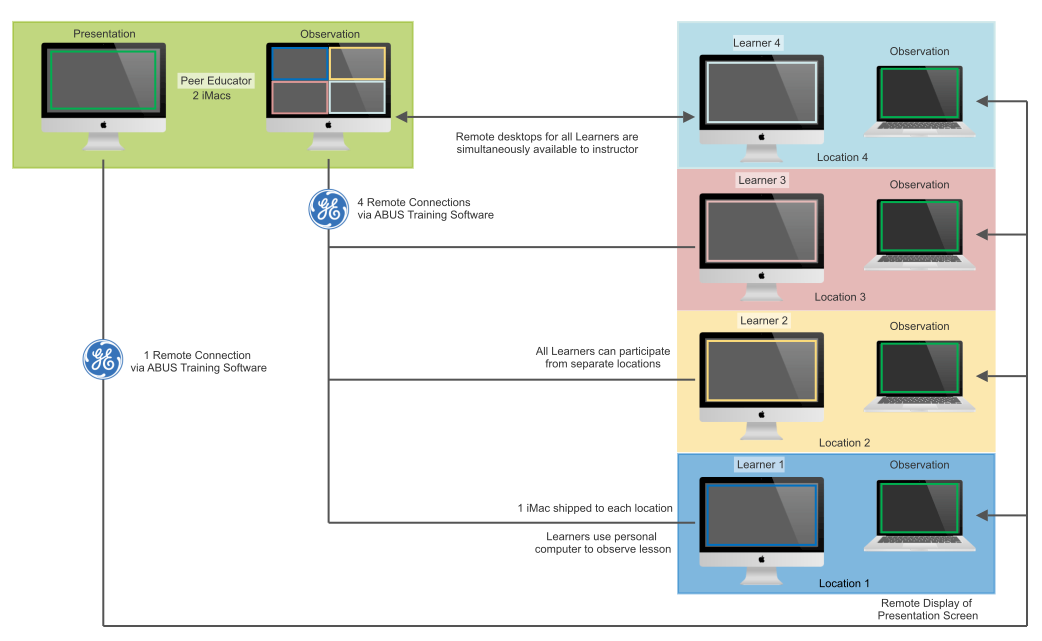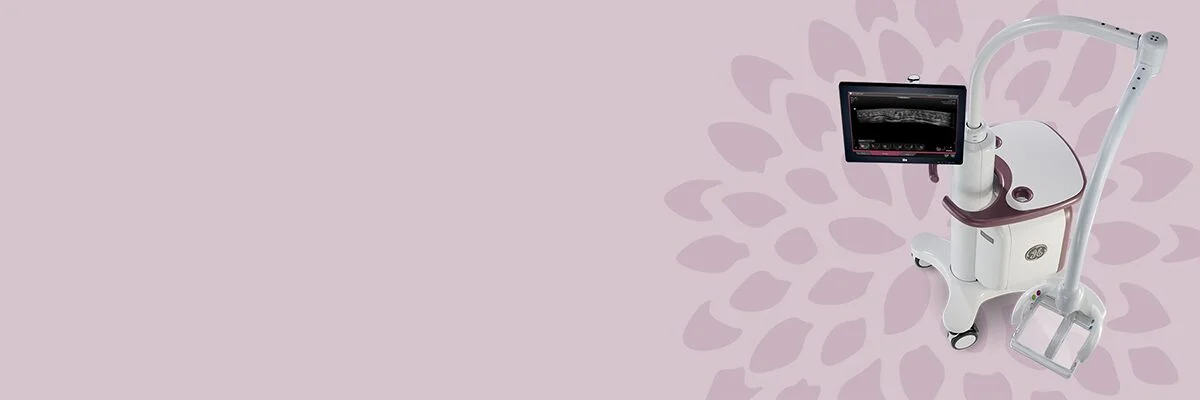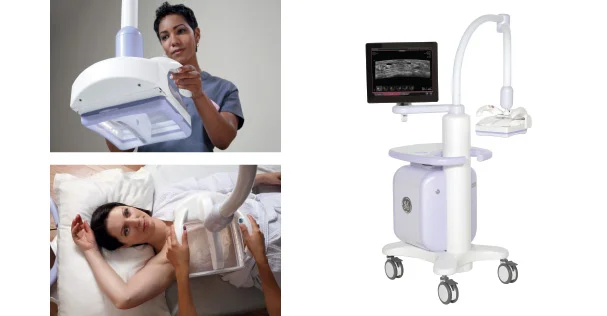ABUS Physician Training
A Cloud-Based Training Program for Breast Imaging Education

ABUS Physician Training Delivery (Redesigned) - The training delivery format after redesign.
Background
From 2013 to 2018, I worked at GE Healthcare as a Breast Imaging Education Project Leader and Technical Support Specialist, within a small team of educators responsible for providing FDA-mandated training to physicians.
I led design and project management for a Cloud-based training platform purposed to deliver education content for Automated Breast Ultrasound, a breast cancer screening technology.
My Role
As the primary designer and researcher on the project, I had the opportunity to collaborate with internal teams (developers, engineers, product management, marketing) and gather feedback from key stakeholders (physicians, hospital management).
My role involved responsibilities outside the scope of User Experience Research and Design, but many of the techniques and strategies leveraged were informed by UX and my background in qualitative research.
Project Goal
Design an efficient, scalable training platform and infrastructure solution for the delivery of GE Healthcare’s Invenia Automated Breast Ultrasound Physician Training curriculum.
Components
Competitive Analysis, Participant Observation, Questionnaire/Survey, Informal Interview, Rapid Prototyping, Task Analysis, Concept Testing, SWOT Analysis, User Testing
Key Responsibilities
Conducted informal interviews with physicians
Designed user surveys and gathered feedback from stakeholders
Synthesized feedback into key themes, user needs and design guidelines
Defined system requirements and constraints
Managed timelines and deliverables
*I can't present the specific findings and design recommendations due to NDA, but I can share the process.
Overview
Over the course of six months, I conducted research, iterated on prototypes and executed user testing.
1. Research
Drafted a project proposal and shared initial plans with internal teams. Attended training sessions as both an educator and learner (participant observation) in order to develop an understanding of user practices and pain points.
Conducted informal interviews with physician learners and peer educators to help determine user needs. Conducted informal interviews with internal teams, and using that information, established guidelines to ensure any new system designs integrate well with existing workflows.
2. Exploration
With the help of several educators on my team, I created affinity diagrams to build a comprehensive picture of Users’ Needs and Users’ current practices.
With input from internal teams, conducted a SWOT analysis of existing programs and practices. Generated affinity diagrams to help explore potential solution strategies.
3. Prototyping
Engaged in concept testing with physicians learners and peer educators to get early feedback on potential solutions. I generated lo-fi prototypes and iterated on designs to explore different solution strategies.
4. Analysis
Conducted a competitive analysis to survey the landscape of education delivery solutions available within the healthcare space.
Analyzed the steps and tasks required to complete a single training session in a task analysis, to ensure all aspects of the system were accounted for when making changes or redesigns.
Synthesized research findings into a report, featuring a comprehensive picture of the problem at hand along with options for solutions and shared with management.
5. Requirements and Development
Generated Product Requirement Documents to detail system requirements and constraints. Generated wireframes and lo-fi mockups to communicate the intended designs to developer.
Interfaced with developers to manage timelines and deliverables. I designed test procedures and leveraged fellow educators to verify requirements were implemented as intended.
6. Design
Redesigned workflows, checklists, user instructions, and process maps to reflect changes to the system. I executed a task analysis of the redesigned system, ensuring all key events were accounted for and any changes complied with FDA-mandated guidelines.
7. User Testing
Scheduled, recruited and moderated 3 pilot sessions (12 participants) using a prototype version of the cloud-based training platform and delivery format. During each session, I kept a log of key incidents and observations. I recorded the sessions with screen-recording software for additional analysis. I administered a post-test questionnaire after each session and conducted informal interviews.
8. Report
A final report was generated and outcomes presented to management.
The Problem
The format used to deliver training to physicians is inefficient and will not scale up to meet predicted needs. A scalable training solution is needed. To give some context:
1. Training = Essential
Physicians who review images captured via GE Healthcare’s Invenia ABUS medical device must complete an 8 hour training curriculum as per FDA mandate. If physicians do not complete the curriculum, use of the device is considered “off label”, and insurance companies are not able to approve or pay for treatments.
2. Scheduling = Headache
Prior to 2015, all ABUS physician training was delivered in a “live” format that involved weeks of coordination with each customer (typically a hospital or private practice).
The delivery format required that a majority of physicians within a radiology group attend a single training event. Physician schedules are typically set months in advance, so coordinating schedules around a specific training date was a recurring pain point for hospital admin.
3. Legacy Solution = Unsustainable
The legacy format was also expensive and unsustainable. Executing a training session required sending cases of training equipment and at least one employee to the customer’s physical location, a practice that would not scale up as product demand increased.
4. Large File Size + Specialized Software
Physicians use Invenia ABUS workstation software to review 3D volumes of breast tissue. The file size for a single volume is large (>1GB), and the software is highly specialized for the task. For this reason, a highly specialized design solution was required.
ABUS Physician Training Delivery (Prior to Redesign)

ABUS Physician Training Delivery (Legacy) - The training delivery format prior to redesign.
Project Goal
Design an efficient, scalable training platform and infrastructure solution for the delivery of GE Healthcare’s Invenia Automated Breast Ultrasound Physician Training curriculum.
1. Assess Pain Points
Gather feedback regarding the legacy training program, with a focus on pain points and areas where the program is not meeting users’ needs.
2. Compliance
Keep all designs and updates in compliance with FDA-specified requirements.
3. Scheduling Solution
Alleviate scheduling and logistical pain points for users.
4. Less Hardware + Software
Reduce the amount of physical equipment and number of third-party applications required to deliver a training session.
Primary Research Questions
What changes in training strategy and delivery format would best address the identified problems?
What tools can help streamline the training process?
Besides the primary pain points, are there any additional pain points for physicians, peer educators or hospital administration?
Can the identified paint points be addressed via updates to the training program? What kind of updates are required?
Design Goals
Insights gained during research and exploration phases contributed to the recognization of a need for a two-part solution strategy. Two project goals were identified.
1. Update Training Program Platform
Design a cloud-based version of the training software to replace the legacy desktop version.
Build a training solution that does not rely on third party applications for essential features like bi-directional screen-sharing and video-chat.
Provide a hassle-free experience for physician learners, hospital administration and Peer Educators.
Build a solution that simplifies the training experience without compromising the high-quality standard established for the program.
2. Update Training Program Delivery
Introduce the flexibility to attend training from any location (home office, etc).
Enable physicians from the same hospital to attend training sessions on different days.
Virtual Classroom: Participants can use their own PCs, hardware, accessories and internet connection.
Figure 4. GE ABUS Invenia Scanstation
Outcomes
Deliverables
Product Requirement Documents
Wireframes and mockups to demonstrate intended functionality and design
A Cloud-Based Training Platform Prototype
Documentation for responsibilities and best practices in relation to the new delivery method and training platform
Pilot program and data from 3 pilot sessions
Implementation Strategy
Implementation
The decentralized training delivery format went live in November 2016. The cloud-based training platform was not implemented beyond the pilot program.
ABUS Physician Training - Delivery (Redesigned)

ABUS Physician Training Delivery (Redesigned) - The training delivery format after redesign.
What did I learn?
1. Balancing the needs of different user groups is a challenge
In the case of the ABUS Training software and delivery platform, physician learners were the primary user group, but other groups (peer educators, hospital admin and internal teams within GE) also used the platform in different capacities. Balancing the needs of different user groups is a challenge, as each group has different motivations and goals. In order to build a well-functioning system, it is essential to work at satisfying the needs of all user groups.
2. Flexibility is paramount
During the course of a project, priorities will naturally shift and evolve as a more complete understanding of user needs develops. It is important to remain flexible and pivot when necessary.
3. Less is more
Some of the “state-of-the-art” features I worked on — features I was most excited about — were not implemented in the final solution, as they were overly complex. Many of the features that added the most value were simple by nature. Complexity is not a measure of quality.




